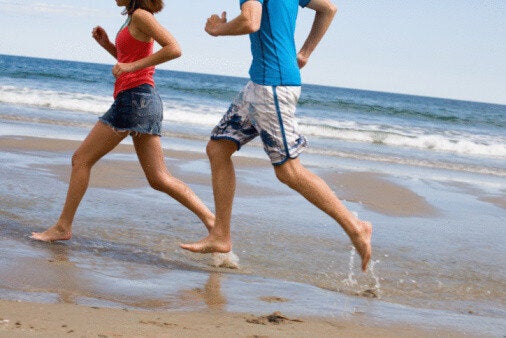
There's this photo of my dad and me running a 10-K that makes me wince whenever I see it. We're side by side, faces set in the same fiercer-than-intended expression (no doubt where I inherited that from). The big difference is in our legs. My dad is landing on the ball of his right foot, which strikes the ground slightly ahead of his torso. His right knee is flexed perfectly, and his left leg, tucked neatly behind him, is poised to come forward in textbook repetition. But as the photo reveals, my dad didn't pass his perfect form down to his son. My right foot is way out in front of me, toes pointed skyward. My knee is locked and my heel is striking the ground. This is called over-striding, and it's one reason some runners develop injuries. Heavy heel-strikers, studies show, can't efficiently absorb and dissipate the impact forces of running, which over time can take a toll on our muscles, tendons and joints.
For two years, I've been trying to improve my running form. Should I have just taken off my shoes? Christopher McDougall thinks so. Thanks in large part to his bestseller, "Born to Run," published in the spring of 2009, barefoot running -- which fosters a forefoot strike and leads to shorter, softer steps -- is again in vogue. Insisting that the human foot supplies all the cushioning and shock absorption any runner needs, McDougall and the growing subculture of barefoot evangelists say that modern running shoes are overbuilt and even harmful, forcing runners to over-stride. When these converts do run in shoes, they're often Vibram FiveFingers, ultralight glove-like slip-ons that have become pop culture curios, appearing on the famous feet of Matthew McConaughey, former NFL star Eddie George and Google founder Sergey Brin.
In response to barefoot fever and the success of the FiveFingers, manufacturers such as Nike, New Balance, Saucony and Mizuno have developed "minimalist" models with less cushioning, lower heel heights and no motion control features. Factor in the weight -- most models are anywhere from three to eight ounces, compared to about 12 for the average running shoe--and you're a long way from the gel, air and EVA foam filled models that the vast majority of runners wear (and annually spend $5 billion on). Most runners believe that cushioning prevents injuries, and that perception isn't likely to change quickly.
While the appeal of going barefoot is simple, the back to basics trend is understandable, there's also a lot of hype and confusion. Runner's World put the craze in context in its November issue ("Is Less More?"), interviewing researchers and designers on both sides of the debate who understand that the injury prevention issue cuts both ways. The majority of us don't have the strength or flexibility in our lower legs to become forefoot-strikers overnight. We need time to adjust without getting hurt. Many podiatrists and physical therapists say they've seen a spike in plantar fasciitis, Achilles tendinitis and other foot injuries suffered by runners who've hastily cast aside their shoes or changed their running form. And even most barefooters admit that there are times when the foot needs minimal protection from asphalt, glass, rocks and the elements.
A few days a week, I wear my Frees around the office. My feet get tired, but that's the point. They're getting stronger. I've also run a few races in seven-ounce minimalist shoes, and yes, I have a pair of FiveFinger shoes. Once I got them on for the first time (more like squeezing into a wetsuit than donning a pair of slippers), I couldn't help but smile. They feel good. I run on grass and can feel my forefoot padding the ground. Still, these aren't my running shoes any more than my road bike is a full-time substitute for my car.
"What are they like?" people ask breathlessly when I wear my FiveFingers to the coffee shop. "Should I be running barefoot?" I tell them that going back to basics can be complicated. There's no scientific evidence that running shoes prevent (or cause) injuries -- just as there's no proof that barefoot running does. And minimalist shoes? It's too soon to tell. But I'll keep running in different shoes for different reasons (and occasionally go barefoot), all with an open mind. And, I hope, a nearer-to-perfect stride.
David Willey is Editor-in-Chief of Runner's World> magazine.